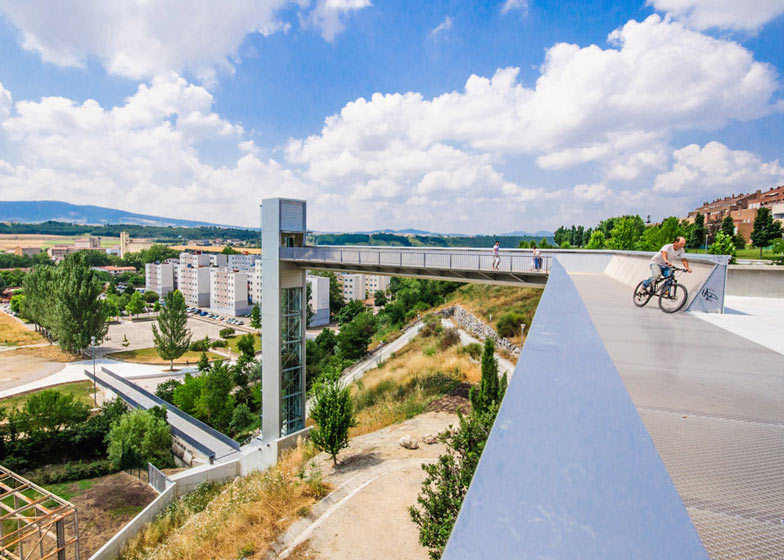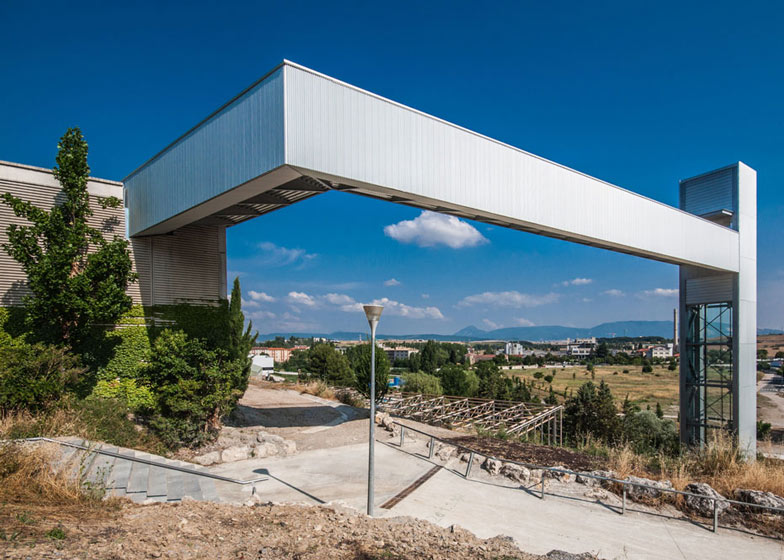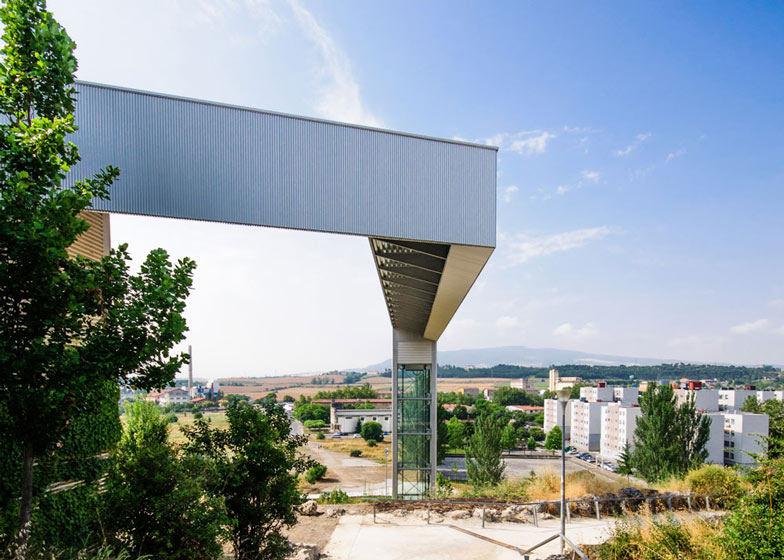This steel and glass elevator shaft designed by Spanish architecture firm Ah Asociados rises out of a hillside on the outskirts of Pamplona in Spain to connect a suburb with the city (+ slideshow).
Ah Asociados, which has offices in Spain and Qatar, designed the Urban Elevator to create a more direct link between the Echavacoiz Norte neighbourhood on the hill and the city below.
Commissioned by the city council, the architects were asked to investigate three possible sites in the city that had all experienced problems with accessibility.
The team settled on the Echavacoiz Norte neighbourhood. Previously, the two parts were connected by a pedestrian ramp and stairs, but city planners felt this could be improved.
The result is an extended steel clad walkway jutting out from the top of the hill in a dog-leg that connects to an elevator shaft offering panoramic views of Pamplona and the hills beyond.
"This made it possible to introduce new pedestrian and cyclist roads between the two urban levels and implement an architectural element that turned the panoramic footbridge and the panoramic tower into one," explained a spokesperson from the studio.
The footbridge is supported by a single horizontal steel beam, with a pavement made from sheet steel plates laid over the top. The plate continues on one side of the footbridge to shelter pedestrians from prevailing winds. The other side features a rail and steel fencing low enough for unspoiled views of the city and surrounding hills.
The elevator shaft is clad in the same sheet steel to give the two separate elements visual continuity.
"The project enhances the simplicity of each element, avoiding any excess of constructive formalism," said the Ah Asociados spokesperson.
Pedestrians approaching the tower from the lower levels cross a small footbridge before ascending up through the transparent elevator shaft. In addition to giving access to the Echavacoiz Norte neighbourhood, the Urban Elevator provides more direct access to a nearby cycleway and park.
Photography is by Imagina2 visualization studio.
Here's some text from the architects:
Urban Elevator in Echavacoiz (Pamplona)
This project emerge from an R+D+I study on Pedestrian Mobility in "Echavacoiz Norte", commissioned by the City Council of Pamplona to the Innovation Department of ah asociados. In this research, three critical areas with historical accessibility and urban integration problems were detected and could be solved by implementing mechanical systems.
One of these three critical areas was to resolve the precarious pedestrian ramp access and stairs which overcome thirty meters height difference between levels. These accesses were also used by neighbours of "Urdanoz Group" to reach the elevated area where there was a perimeter walkway and the neighbourhood of "Echavacoiz Norte".
This project was intended to solve current accessibility problems through two footbridges and a lift, which turned into an urban reference of the integration of Echavacoiz into the city and into an object sensible to its own urban landscape. This has been possible by linking the upper pathway with the river park and with the future neighbourhood of the AVE.
The pathway along the Elorz River and the one to the neighbourhood encountered in the bridge. This made it possible to introduce new pedestrian and cyclist roads between the two urban levels and implement an architectural element that turned the panoramic footbridge and the panoramic tower into one.
The project enhances the simplicity of each element, avoiding any excess of constructive formalism. The great structural effort of the uneven footbridge has been solved by a robust section that extends between its bases and creates an image of an arcade opened to the new neighbourhood.
The basic shape of the footbridge is formed by a continued beam from which the supports of the footbridge pavement are born. This pavement has been made of sheet metal plates. The exterior of the beam and the lateral levels of the tower are also covered by a folded steel plate to get visual continuity to enhance the urban character of an element that emerges from the hill and is supported by the head of the footbridge.
The horizontal part of the bridge turns into vertical where it meets the tower, in such a way that the format of steel structure element and steel skin is repeated. The asymmetry of the footbridge protects the pedestrians of wind and let them see a new territory whilst the vertical element is robust and strong in its lateral levels. The landings opened to the landscape with the minimum expression of materials.
The two main features of this project are formal simplicity and clear structure. These two define an element that is converted into a reference, a gate and a connection between two urban realities that are no longer separated by a topography that caused marginalization and now union.





